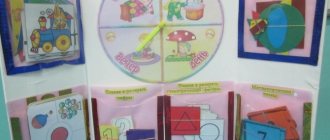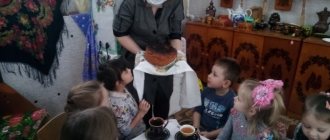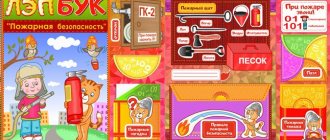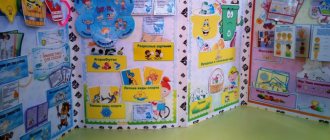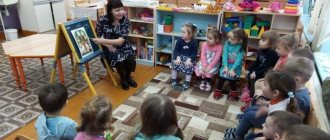Methodical manual “Lapbook on moral and patriotic education of older preschoolers”
Toolkit
LAPTOP BOOK ON MORAL AND PATRIOTIC EDUCATION
Direction
– Moral and patriotic education
Educational institution
- Kindergarten
Age group
– Senior preschool age (5-7 years)
Lapbook theme
- “Our Motherland”
Author-compiler
—
Nalivaiko Anna Olegovna
(teacher of the State Institution of the LPR “Lugansk preschool educational institution of a combined type nursery-kindergarten No. 107 “Ship”)
Relevance of the chosen topic:
The topic “Moral and Patriotic Education of Preschool Children” is closely intertwined with the concept of “my Motherland”. The child should understand as early as possible that his homeland is a country with its own state symbols and holidays, and national traditions.
The relevance of patriotic education is to raise children in the spirit of love for their homeland and respect for values, attachment to the place of their birth, pride in their people.
Target:
formation of ideas and systematization of knowledge about the Motherland (LPR) and the small Motherland (Lugansk)
Tasks:
1. To form and consolidate knowledge about the head of state, state symbols, and the meaning of one’s native land for a person;
2. Continue to get acquainted with small folklore genres, with poems about your hometown;
3.Enrich the active vocabulary with new words, encourage children’s curiosity;
4. Introduce children to the sights (monuments, architectural buildings) of their hometown;
5. Develop cognitive abilities;
6. Develop patriotic feelings: love for the native land, careful attitude towards its natural resources, respect for people’s work.
Contents of the manual:
Page 1. Title of the manual
1 BLOCK “LUGANSK PEOPLE’S REPUBLIC”
Page 2.
Portrait of the head of the Lugansk People's Republic Leonid Pasechnik. State flag of the LPR, coat of arms.
Target:
formation and consolidation of knowledge about the head of state, consolidation of knowledge about color, the sequence of colors in the state flag, and the meaning of each of them. Contribute to the consolidation of knowledge of the flag and coat of arms of your country.
Page 3.
Anthem of the Lugansk People's Republic. Proverbs about the Motherland.
Target:
development of auditory perception, attention and patriotism, continue acquaintance with small folklore genres, the meaning of the native land for a person, the importance and need to protect and appreciate one’s homeland.
Page 4.
Fauna and flora of the native land
Folder “Red Book of the LPR”
(endangered plants, insects, birds and animals).
Goal: to introduce rare representatives of the flora and fauna of the native land, talk about the significance of the Red Book, and cultivate a caring attitude towards nature.
Natural resources of the native land.
Goal: to study the minerals of the native land, their significance in people’s lives (professions related to resource extraction; significance in different areas of application of the resource, rarity in the world).
D/i “Find an animal by silhouette”
Goal: to introduce representatives of the animal world of the Lugansk region, to develop perception, attention and memory.
2. BLOCK “HOME TOWN LUGANSK”
Page 5.
Folder “Famous people of Luhansk region”.
Goal: to introduce children to cultural and artistic figures who glorified their native land (actors, singers, poets, architects, sculptors), military personnel (World War II participants), athletes, scientists.
Poems about hometown
Goal: to introduce the small homeland and its attractions through artistic expression.
Page 6.
Didactic game: "The third wheel."
Goal: to acquaint children with the symbols of their native country, to teach them to distinguish the flag and coat of arms of the Lugansk People's Republic from among the flags and coats of arms of other countries.
Didactic game: “Puzzles”.
Goal: to consolidate children’s knowledge about the symbols of the LPR and the city of Lugansk (the flag, coats of arms), what is drawn on the coat of arms and what it means.
Page 7.
Portrait of the head of the Lugansk city administration, Manolis Pilavov. Coat of arms of the city of Lugansk.
Target:
formation and consolidation of knowledge about the head of the city, consolidation of knowledge about the meaning of the elements of the coat of arms. To help consolidate knowledge of the coat of arms of your small homeland.
Page 8
Board games “Travel around your hometown”
The set includes 3 fields: “Travel along Sovetskaya Street”, “Travel along Oboronnaya Street”, “Travel to interesting places in the city of Lugansk”.
Goal: to introduce children to the sights (monuments, architectural buildings) of their hometown, to form and consolidate knowledge about the sights.
The methodological manual covers 4 educational areas of preschool education according to the Federal State Educational Standard:
Cognitive development
– acquaintance with the state symbols of the republic and the city of Lugansk; with the main attractions of the city, famous personalities, minerals and the Red Book of the LPR.
Speech development
— the world of native speech through artistic expression, folklore (poems about Lugansk, proverbs about the Motherland).
Social and communicative development
– development of cognitive activity, development of a sense of patriotism.
Artistic and aesthetic development
– study of the anthem of the LPR, photographs of their hometown.
This teaching aid can be used in different types of activities: in direct educational activities, with a group of children, in classes in subgroups, in individual activities and training, in independent activities of children.
Methodological development of the LAPTOP “We are different, but we are together”
Korepanova Lyubov Gennadievna
Teacher of MADOU "Kindergarten No. 92"
Berezniki, Perm region
Methodological development of the LAPTOP “We are different, but we are together”
Target:
formation of attitudes of tolerant consciousness of students, formation of skills to live in a multicultural society.
Tasks:
1. Form a respectful attitude, openness, and friendliness towards peers, their parents, and employees of the institution.
2. Introduce national costumes and outdoor games of different peoples of Russia.
3. To cultivate love and respect for one’s Motherland, for one’s nationality, and a tolerant attitude towards representatives of other nationalities.
4. Develop communication skills, cognitive activity, develop creativity and imagination.
Relevance:
Today, hostility, anger, aggressiveness, mutual intolerance and cultural egoism are becoming increasingly widespread among children. There are many reasons for this - the media, the social environment of children, and misunderstanding of each other arises in connection with different values, culture, and language. Practical experience in developing children’s skills of social responsibility and respectful relationships between children, regardless of physical abilities or nationality, is still insufficient. Much attention is paid to the civic and patriotic education of the younger generation. A problem has arisen: How best to interest and captivate children in activities aimed at exploring their native country? How to preserve the found material so that even after the completion of the activity it continues to attract children, encouraging them to further independent research. This find turned out to be a laptop.
Lapbook (lap – knees, book – book).
Literally translated,
a lapbook is a book on your lap
. You can often find other names: thematic folder, interactive folder, project folder. But the essence comes down to the fact that a lapbook is a homemade interactive folder in which educational material is collected in the form of pockets, mini-books, windows, moving parts, inserts that a child can take out, rearrange, fold at his own discretion. It collects material on a specific topic.
Also, the lapbook necessarily includes various creative tasks.
A laptop, at first glance, looks very similar to a large application.
What happens to the applique after it's done? It takes its place among other works in the closet and does not bring any benefit. A child cannot play with it, so not all children like to make appliqués - they simply don’t see much point in doing something that then disappears from their lives forever. Children are very practical. After all, a lapbook is, first and foremost, a learning tool! From constant contact with a book, a child learns the material simply perfectly and without any effort. Moreover, without effort, both on the part of the child and on the part of the parent/teacher - everything happens by itself. A laptop is not only a powerful reference tool and a special form of organizing educational material, it is, first of all, the basis for partner project activities between an adult and children (a teacher with students, a parent with a child). The basis of the lapbook is created by the teacher and supplemented and improved together with the children and their parents. The result of this work is a well-developed research project. Lapbooks help you quickly and effectively learn new information and consolidate what you have learned in an entertaining and playful way. The joint search activity of a child and an adult (teacher, parents) allows the child to actively act independently and stimulates teamwork skills. Form of classes:
A laptop is the final product of joint work with children on a particular topic.
Its production should be preceded by thematic activities and games, discussion of complex issues, and completion of assignments. In this case, the child will be ready to make a thematic folder with you, and it will really play its role as a reinforcing, systematizing didactic and gaming aid. When working with a group of children, two options are possible: either the teacher distributes tasks among the students, and together they collect and fill out one folder. Or the teacher shows a master class, and with his help the children make each of their own copies of the folder with the help of their parents. The size of the finished laptop
is standard around the world - A4 folder when folded and A3 when open. This size is ideal for a child to be able to work with a lapbook independently: hold it in their hands, write and complete tasks in it, and after class put the folder on the shelf.
Recommended age for lapbook lessons
- 5 years and above. Children 7-8 years old can already invent and make their own lapbooks completely independently.
Practical significance:
The implementation of this project will increase the knowledge of parents in the field of teaching tolerance to their children. And children, in turn, will learn a friendly attitude towards each other, responsiveness and fairness. All of the above should make a significant change in the psychological climate of the group and influence the improvement of the quality of the educational process.
Project participants:
children, teachers, parents.
Age:
children 5-6 years old
Project type:
cognitive - creative.
By number of participants:
collective.
By duration:
short.
Project product:
Lapbook: “We are so different, but we are together!”
Preliminary work:
Creation of card files of outdoor games and entertainment of the peoples of Russia.
Creation in the group of a library of works of translated literature from different nations, fairy tales, proverbs and sayings about peace, friendship, kindness, home and Motherland.
Interior decoration of group premises with illustrative material on the topic. Introducing household items, folk arts and crafts, dolls in national costumes, and musical instruments.
Practical activities:
-Consideration of the state symbols of the Russian Federation.
-Reading and memorizing excerpts of poems about the friendship of peoples, their unity.
-Lotto game “Russia is a friendly family of nations!”
- Outdoor games of the peoples of Russia.
-Coloring coloring pages “Russia is a multinational country!” parents and children (costumes of the peoples of Russia)
Working with parents:
Blitz survey for parents: “What do you understand by the word tolerance?”, “Family traditions.” Excursion to the historical and ethnographic museum.
Expected results:
-The group will create conditions for the development of tolerant relationships in children.
-Children will gradually develop such qualities as responsiveness, fairness, modesty, and a friendly attitude towards each other, regardless of nationality, culture, social status and physical abilities.
-The relationship will be strengthened in matters of nurturing tolerant relationships between the family and the kindergarten. Parents will change their passive position to an active one, acquire knowledge in the field of nurturing tolerant relationships and, most importantly, put them into practice.
Photo report
